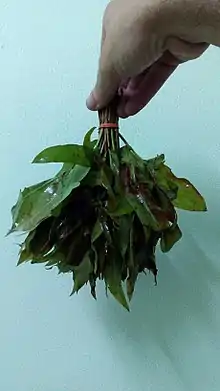Cratoxylum formosum
Cratoxylum formosum is a species of flowering plant in the Hypericaceae family. Its commercial name in timber production is "mampat".[2]
| Cratoxylum formosum | |
|---|---|
 | |
| Scientific classification | |
| Kingdom: | Plantae |
| Clade: | Tracheophytes |
| Clade: | Angiosperms |
| Clade: | Eudicots |
| Clade: | Rosids |
| Order: | Malpighiales |
| Family: | Hypericaceae |
| Genus: | Cratoxylum |
| Species: | C. formosum |
| Binomial name | |
| Cratoxylum formosum Benth. & Hook. f. ex Dyer | |
It is a tropical plant found in Brunei, Burma, Cambodia, China, Indonesia, Laos, Malaysia, the Philippines, Singapore, Thailand, and Vietnam. The trees flower when there is dry weather followed by wet weather than dry weather again. It has pink flowers and can be up to 20 meters tall, though they rarely achieve the size required for timber exploitation.[2]
The Catalogue of Life lists the subspecies C. formosum subsp. pruniflorum (Kurz) Gogelein
In Laos, Cratoxylum fomosum trees are used:
- for the production of charcoal [3]
- for their edible young leaves, which can be differentiated as either sour (ສົ້ມ), smooth (ມ່ອນ) or blood-red (ເລືອດ), possibly depending on subspecies (such as sp. prunifolium).
Local names:
- Laotian: ໄມ້ຕີ້ວ [mâi tȋːw]
- Malay: mampat
- Thai: ผักติ้ว Phak tiu
- Vietnamese: thành ngạnh đẹp (subsp. prunifolium : thành ngạnh vàng)
References
- "IUCN Red List of Threatened Species. Cratoxylum formosum". IUCN Red List of Threatened Species. Retrieved 13 March 2017.
- "'Mampat' entry in the Wood Explorer database". The Wood Explorer database. Retrieved 23 June 2011.
- "Charcoal maker rewards villagers for growing mai tiew". Vientiane Times. 2011-06-21.
This article is issued from Wikipedia. The text is licensed under Creative Commons - Attribution - Sharealike. Additional terms may apply for the media files.

